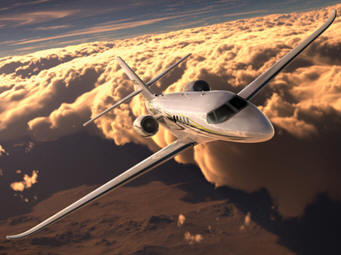|
|||||||||||||||||
|
|
|
|||
|
Pratt & Whitney
PW306D Turbofan To Power Cessna's New Citation Latitude By Steve Hall |
||||
 |
October 11, 2011 - Pratt & Whitney announced that its
PW306D engine has been selected by Cessna Aircraft
Company to power its new Citation Latitude mid-size
business jet. The announcement was made at the National
Business Aviation Association (NBAA) annual meeting and
convention in Las Vegas, Nevada.
The new Citation Latitude will have space for a crew of
two, plus up to eight passengers. Powered by the PW306D
engine, which can deliver 5700 pounds of thrust, the new
aircraft has a full fuel payload of 1,000 pounds (454
kilograms), a maximum cruise speed of 442 knots true
airspeed and a range of 2,000 nautical miles. "We are delighted to be selected by Cessna to power their new business jet, and build on our long-standing relationship, which has spanned more than 40 years," said Maria Della Posta, Senior Vice President, Marketing, Pratt & Whitney Canada. |
|||
|
"It is
telling that on the same day we are celebrating the 20th
anniversary of the PW300 engine we are announcing an entirely
new application aboard a state-of-the-art business jet. We have
consistently made the right investments in technology and
innovation to keep the PW300 family of engines in demand for new
applications as they evolve."
"The
Citation Latitude is a game-changer for the mid-sized segment,
offering the payload, speed and range the market requires with
an unmatched cabin experience at this price point," said Brad
Thress, Senior Vice President, Cessna Business Jets.
Cessna
introduced the new Citation Latitude mid-size business jet at
the start of the 64th NBAA Annual Meeting and Convention. This
is Cessna?s second new product announcement in the past 14 days;
the company launched the Citation M2 light business jet on Sept.
26. |
||||
|
With space for a
crew of two plus up to eight passengers, the Citation Latitude features
Garmin G5000 avionics and a clean-sheet, 84-inch fuselage for a 6-foot
high, flat floor passenger cabin.
Positioned between
the Citation XLS+ and Citation Sovereign in Cessna?s product line, the
Citation Latitude offers a full fuel payload of 1,000 pounds (454
kilograms), a maximum cruise speed of 442 knots true airspeed (819
kilometers per hour) and a range of 2,000 nautical miles (3,704
kilometers). The aircraft is priced at $14.9 million in 2011 USD.
Preliminary
specifications project the aircraft will operate at airports with
runways as short as 3,900 feet (1,189 meters), will have a maximum
altitude of 45,000 feet (13,716 meters) and will climb direct to 43,000
feet (13,106 meters) in 23 minutes. First flight of the Citation
Latitude prototype is expected to be mid-year 2014, with FAA
certification (Part 25) and entry into service expected in 2015.
From just behind
the cockpit through the rear lavatory, a flat floor provides stand-up
access throughout the 16-plus foot cabin. The main passenger cabin ?
Cessna?s widest in history ? is 77 inches wide (1.95 meters) with a
height of 72 inches (1.83 meters). The standard seating arrangement
accommodates passengers in a single-club with a forward, dual
side-facing couch. Six pedestal seats track forward and aft 7 inches
(.18 m) and laterally 4 inches (.10 m) on the seat base with 180 degree
swiveling capability and infinite recline positions. Cabin-length
indirect LED lighting is provided overhead in the passenger service
units with variable adjustment for direct reading lights and more.
?The requirements
for business travel have evolved to more than comfort and convenience;
the use of innovative technology is key to providing a more efficient
and productive aircraft cabin, which is critical to meeting expectations
of a fully functioning work environment,? said Cindy Halsey, Cessna vice
president, Interior Design, Engineering and Development. ?Through our
new ClairityTM cabin technology system, we have an intuitive user
interface to offer customers a ?smart? airplane for the ultimate
connectivity experience.?
Developed by
Cessna in partnership with Dallas-based Heads Up Technologies, Clairity
is an intelligent cabin technology solution that ties into the aircraft
avionics systems and can integrate cabin electrical systems and data and
communication sharing through a fiber optic backbone controlled through
either an intuitive touch-screen user interface at each seat or the
customer?s personal electronic device. |
|
|
 |
| ?AvStop
Online Magazine
Contact
Us
Return To News
|
|

